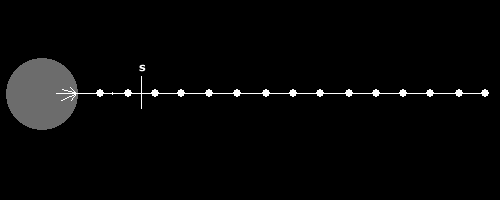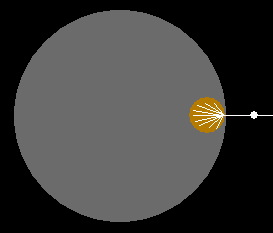
Orbital Siphon Braking
Siphon foundations
At its base, an orbital siphon exerts a force that acts radially outward. This is the exact converse of conventional terrestrial buildings, and it means that the foundations at the base of a siphon must act as an anchor.
This suggests that the siphon foundations should be akin to the roots of trees, and extend deep underground, and be hooked along their length to the strata through which they pass. Such roots might be produced by using oil drilling technology to drill corkscrews tunnels, and then lower high tension cables down them, and finally locking them in place.

 The siphon root system would in effect bind together a mass of rock which would act as a counterweight to the force exerted by the tower.
The siphon root system would in effect bind together a mass of rock which would act as a counterweight to the force exerted by the tower.
With a light tower raising little mass, the counterweight would be small. But a massive tower raising large masses, the counterweight would correspondingly large. If this root system failed, it would either do so because the root system failed in tension, or because the entire counterweight of rock was uprooted.
In the case of a cantilever truss siphon, the counterweight would be holding down the both the truss and the braking system used to restrict the radial velocity if the rising train of masses.
Siphon braking
The braking system would be located at the base of the tower, and most likely tied into the counterweight roots. Braking has to be done at the base of the tower if the rising train is to be constrained to a constant radial velocity.
There may be many possible braking systems.
One possible brake would be a simple friction brake, much like a car brake. But this sort of brake would generate a lot of heat, and would repeatedly wear out and need replacing.
Another possibility might be to simply increase the mass of the lowermost bodies in the rising train, and gradually release the extra mass from each body as it rose. The extra mass might simply be sea water. The rising tower would resemble a fountain as the water cascaded down it.
Yet another possibility would be to use the atmosphere to provide air braking. Again, this would generate heat. A variant of this would be to set the tower base under sea, and use water braking. Again, this would generate heat.
In generating heat, or raising extra mass, the braking system would be performing work. And rather than allowing this work to be simply dissipated as heat, it might be possible to use the brake to do something useful, like generate electricity.
 The rising chain of masses might, in a simple example, be made to turn a drum connected to an electric dynamo. The mechanical work done by the rising chain would be converted into electrical energy. In fact, it might be connected to a whole train of dynamoes, connected by clutches, such that if radial velocity Vr rose too high, more dynamoes would be hooked up, and if Vr fell too low, dynamoes would be unhooked.
The rising chain of masses might, in a simple example, be made to turn a drum connected to an electric dynamo. The mechanical work done by the rising chain would be converted into electrical energy. In fact, it might be connected to a whole train of dynamoes, connected by clutches, such that if radial velocity Vr rose too high, more dynamoes would be hooked up, and if Vr fell too low, dynamoes would be unhooked.
If the tower exerts an outward radial force F at its base, and the tower rises radially at a velocity Vr, then the power W generated by the rising tower will be
W = F . Vr
Converted into electrical power, this might assist other tower-related activities. For example, new payloads might be accelerated up to Vr before beginning radial ascent using such a power source.
Starting and stopping a siphon
Without braking of some sort, a siphon will tend to accelerate. Payloads will rise faster and faster. At some point, the siphon will disintegrate. Siphon braking is intended simply to restrict the rising chain of payloads in the siphon to some maximum radial velocity.
To start a siphon, an immobile chain of payloads must be pre-positioned to form a tower. The siphon is then started by releasing the chain at the base, allowing it to gather speed until it reaches maximum radial velocity Vr. To stop a siphon, braking would have to be gradually increased to slow the rising train of payloads, until it finally stopped rising.
A variant of this would be for start payloads to be of low mass, gradually increasing in mass towards desired payload mass. End payloads would then be reduced in mass. The result would be that less work would need to be done by the brakes to stop a siphon. The entire chain of payloads would then resemble a snake.

